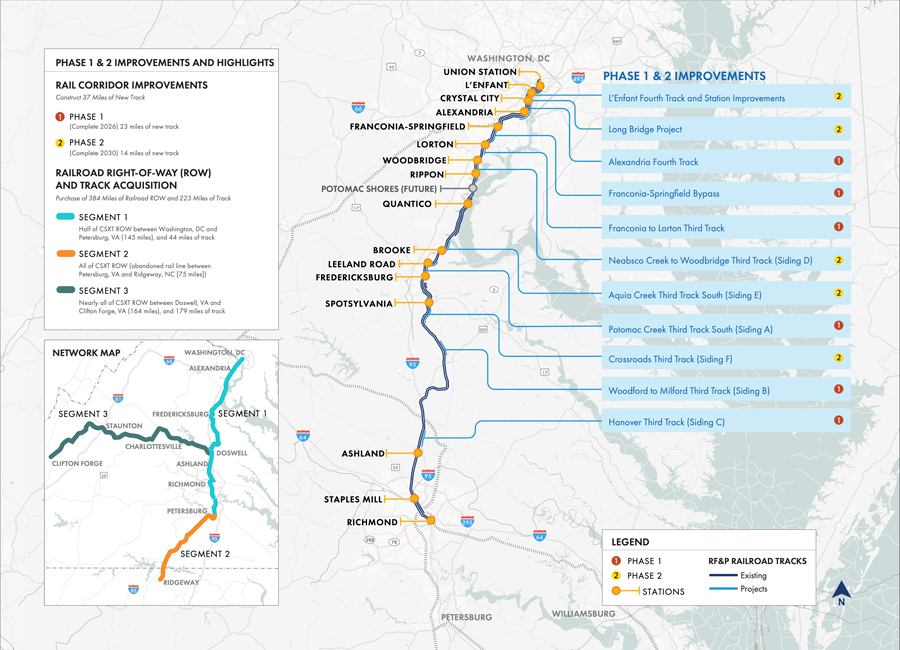Linking Key Eastern Cities
The U.S. capital and North Carolina’s largest city are about 400 miles apart. Today, Washington DC and Charlotte are linked by one daily Amtrak state-supported service—The Carolinian—which takes approximately 10 hours to make the journey between these key cities. Home to important economic hubs, government institutions, rural communities, and multiple educational centers, this corridor deserves vastly improved service.
Fortunately, significant investment from the state and federal level, long-range planning, coordination, and commitment from various stakeholders promise higher levels of service in the future. Here are some of the key projects that will enable the Charlotte – Washington DC corridor to become a faster, more frequent, and reliable option for travelers across the eastern US.
*Note, the Crescent also links Charlotte and Washington, DC, but only shares a limited section of its corridor with the Carolinian, as the Crescent takes a route through central Virgnia and North Carolina.
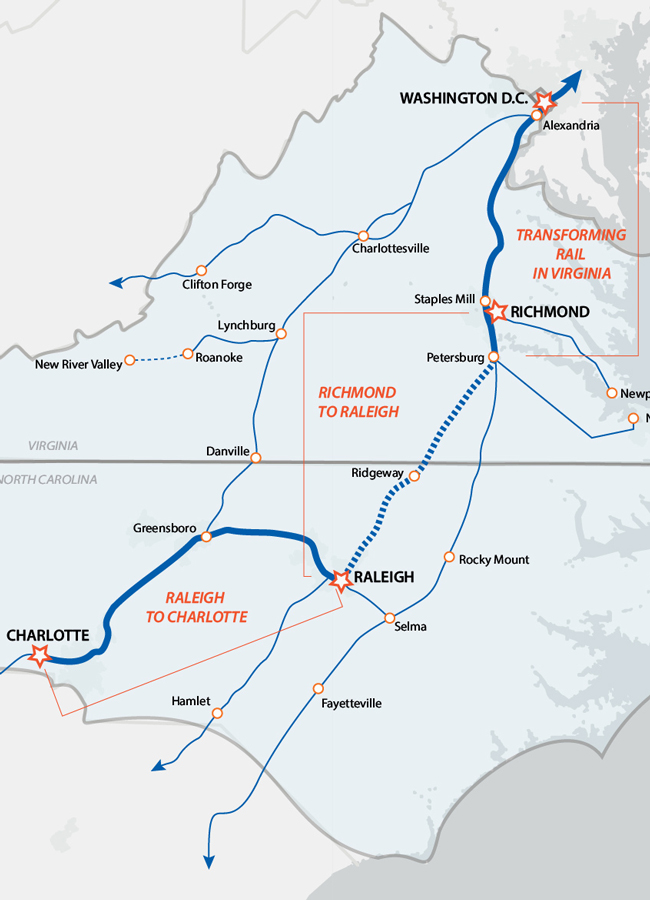
A distance of more than 400 miles across two states and DC, the Charlotte – Washington DC corridor links major cities, state capitals, and education centers in North Carolina and Virginia.
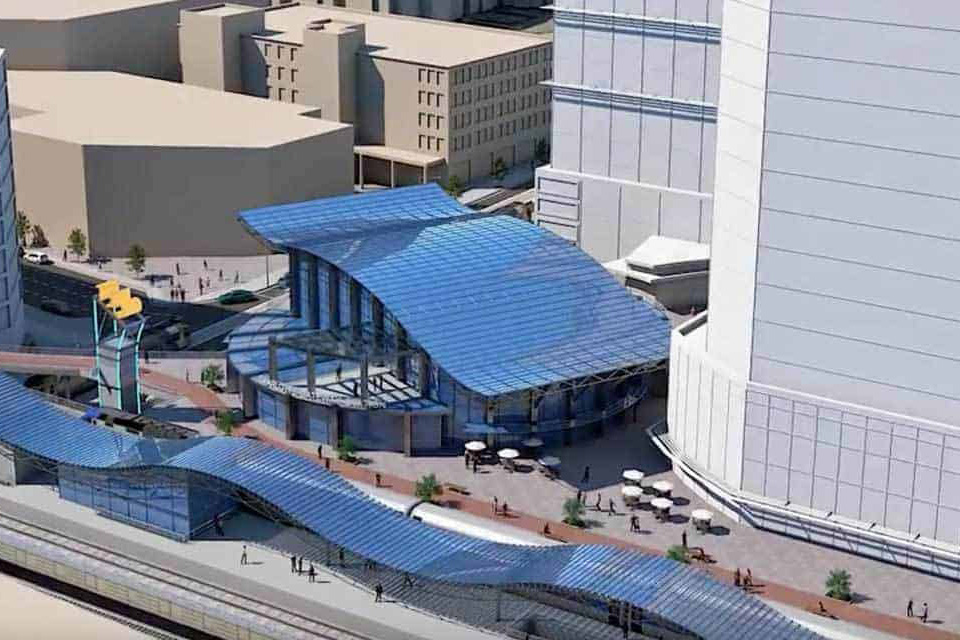
With the first phase complete, the Charlotte Gateway Station (foreground) is expected to begin passenger service in 2026-27.
Charlotte, NC
Beginning at the southern end of the Carolinian route, Charlotte is North Carolina’s largest city and the Southeast’s largest financial hub. Currently, the Carolinian’s terminus in Charlotte is a small station in an industrial area more than a mile north of downtown. However, the phased introduction of Charlotte’s new Central Station through the late 2020s will see Carolinian and Piedmont services arriving and departing from a modern, high-platform station much closer to downtown. The Charlotte Gateway Station Project will be accompanied by several high-density developments, a new Greyhound bus terminal, a mixed-use path network, and easy connection to the Lynx Gold Line Streetcar. Implementation of this new station will improve the passenger experience and is expected to further boost Amtrak ridership in Charlotte.
Charlotte – Raleigh
Heading north from Charlotte, Amtrak trains make seven intermediate stops over the 175-mile Piedmont Corridor on their way to the state’s capital in Raleigh. in the 1990s, the Sealed Corridor Program improved more than 200 railroad crossings. These included road closures, grade-separation projects, implementation of crossing gates, and ticketing through video enforcement.
In the 2010s, the Piedmont Improvement Program included further grade-separation projects and track projects like curve smoothing and double tracking to add capacity and improve speeds. Completed in 2018, this program enabled more passenger trips on the corridor, with a fifth daily Piedmont round-trip added in 2023. The program’s infrastructure upgrades also created greater reliability and decreased travel time, while new station amenities improved access.
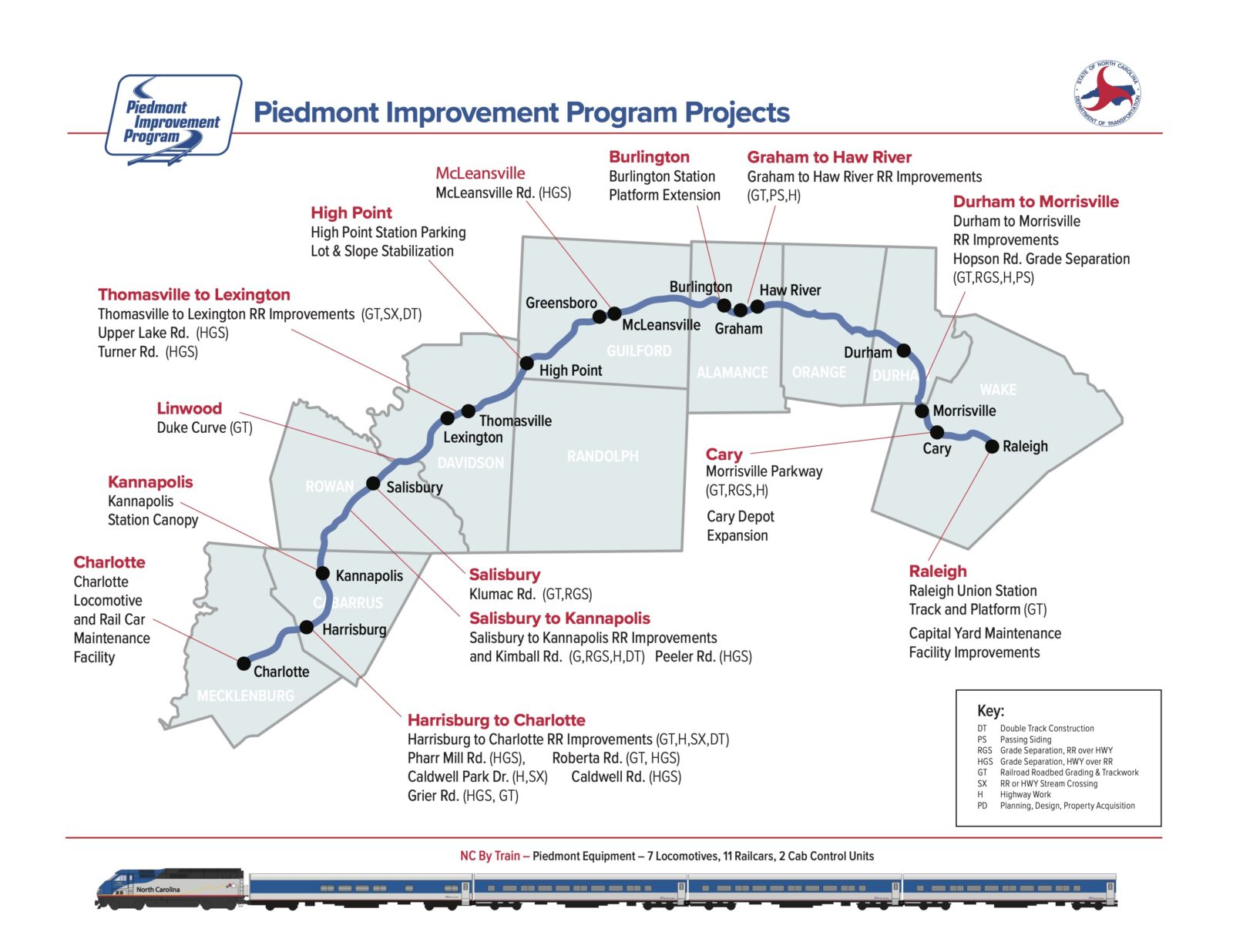
The Piedmont Improvement Program introduced a variety of infrastructural upgrades which improved service between Charlotte and Raleigh.
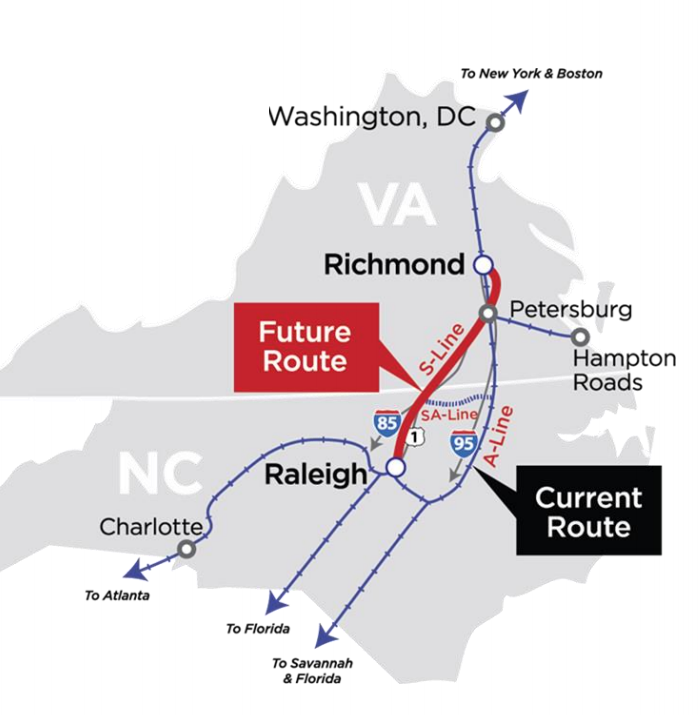
The S-Line will shave 90 minutes off the Raleigh – Richmond travel time.
Raleigh to Richmond – The S-Line
After passing through Raleigh, the northern terminus of Amtrak’s Piedmont service, the Carolinian continues on a circuitous, CSX-owned 175-mile corridor toward Richmond, Virginia. This route is slow and unreliable.
A state compact between Virginia and North Carolina seeks to move services between the state capitals to a mostly dedicated passenger-rail corridor called the Raleigh to Richmond S-Line. The Commonwealth of Virginia purchased 75 miles of S-Line right-of-way between Ridgeway, North Carolina and Petersburg, Virginia in 2020, while the State of North Carolina purchased the remainder of the S-Line corridor in 2023. The state governments will reconstruct the tracks and stations, making the S-Line the primary link for trains between Raleigh and Richmond.
North Carolina received funds from the Federal-State Partnership program to construct the first segment from Raleigh to Wake Forest, including track improvements, grade separations, and station construction.
When complete, the S-Line project will cut 50 miles and nearly 90 minutes off the existing route.
Richmond Main Street Station
From Petersburg, Virginia north, the Charlotte to Washington corridor rejoins the existing route toward Virginia’s state capital, Richmond. This route bypasses Richmond’s downtown Main Street Station and serves the suburban Staples Mills station six miles northwest of downtown.
Rehabilitating the Centralia – Richmond section of the S-Line, combined with reconstructing Main Street Station’s northwest platforms, would enable all trains to stop at the historic downtown station, improving connectivity to the densest parts of Richmond and to the Virginia state capital.
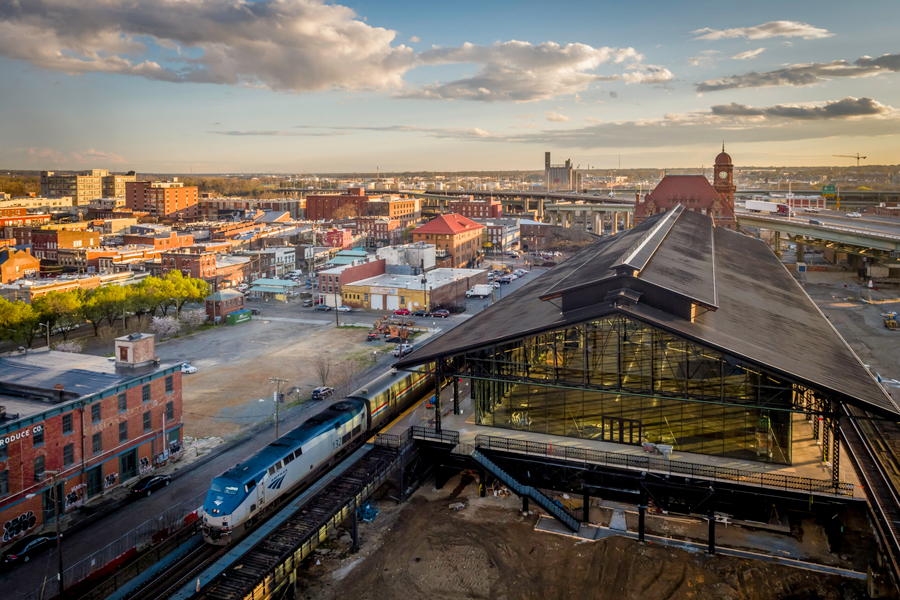
Reconstruction and refurbishment of aging infrastructure in Richmond would enable rerouting of southeast Amtrak trains back into this historic station.
Funding has been guaranteed for projects across the DC2RVA corridor, enabling faster, more frequent, and higher quality service by the end of the decade. (click for pdf)
Richmond to Crystal City
Departing north from Richmond Main Street Station, services on the DC to Richmond (DC2RVA) corridor rejoin for the final 120 miles into Washington Union Station. In early December 2023, Virginia agreed to purchase 112 miles of right-of-way and 39 miles of track along the corridor from freight operator CSX Transportation. This purchase enables the Virginia Passenger Rail Authority to continue their Transforming Rail in Virginia project, which includes a number of grade-separation and bridge projects, implementation of triple- and quad-track sections, a new bypass at Franconia-Springfield station, and a rail flyover in Alexandria separating north and southbound trains. These investments will improve travel times and allow service between Richmond and Washington, DC to grow from 6 to 11 daily round trips by 2030.
The Long Bridge
Just northeast of Crystal City and spanning the Potomac River is the CSX-owned Long Bridge. Built in 1904 to connect Washington, DC and Virginia, this span more than a century old presents a significant bottleneck for routes across the Southeast. All routes which serve Washington, DC and points further south must traverse the Long Bridge, which is at 98% capacity during peak times. The Long Bridge Project will construct a new double-track rail bridge and a pedestrian bridge adjacent to the original Long Bridge. This project will effectively double capacity south of Washington, DC, unlocking increased levels of service on all routes in the Southeast High Speed Rail Corridor.
This project was awarded a Federal-State Partnership grant in 2023 and will start construction in 2024.
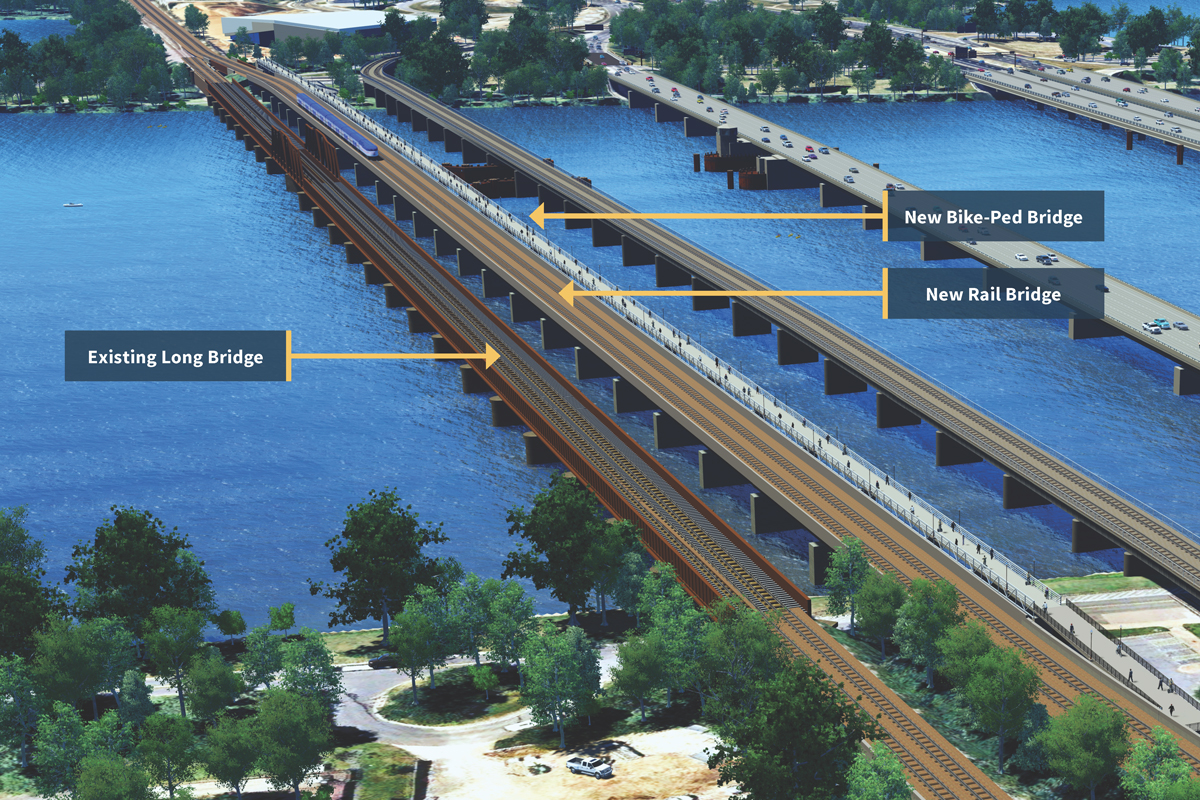
The New Long Bridge is planned to begin construction in 2024 and enter into service in 2030, creating significant opportunities for passenger rail expansion in the southeast.
Conclusion
Virginia and North Carolina have done an excellent job in generating exciting changes and a promising future for passenger rail in the Southeast. Long-range planning, intergovernmental coordination, slow-and-steady acquisition of rail corridors, and consideration for how to create synergies between projects have been the main drivers of success.

Take Action
The country needs an Interstate Railway Program, like the Interstate Highway Program, to take full advantage of the community, economic, and environmental benefits of trains.
Please join with us in asking Congress to create a national railway program to re-connect America with fast, frequent, and affordable trains.
